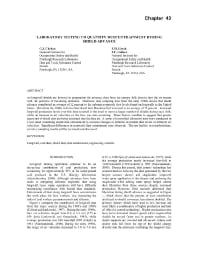Mining Publication: Laboratory Testing To Quantify Dust Entrainment During Shield Advance
Original creation date: June 2001
Authors: GJ Chekan, JM Listak, JF Colinet
NIOSHTIC2 Number: 20021276
Proc Seventh International Mine Ventilation Congress, 2001, (17-22 June, 2001: EMAG 2001, Krakow, Poland), S. Wasilewski, ed. :291-298
As longwall shields are lowered in preparation for advance, dust from the canopy falls directly into the air stream with the potential of becoming entrained. Historical dust sampling data from the early 1980s shows that shield advance contributed an average of 12 percent to the airborne respirable dust levels found on longwalls in the United States. Data from the 1990s indicates that shield dust liberation had increased to an average of 23 percent. Increased longwall production levels over this time resulted in the need to move a larger number of shields during each shift, while an increase in air velocities on the face was also occurring. These factors combine to suggest that greater quantities of shield dust are being entrained into the face air. A series of controlled laboratory tests were conducted in a test stand simulating shield dust entrainment to evaluate changes in airborne respirable dust levels at different air velocities. Significant differences in respirable dust entrainment were observed. The test facility, test methodology, and dust sampling results will be reviewed and discussed.

NIOSHTIC2 Number: 20021276
Proc Seventh International Mine Ventilation Congress, 2001, (17-22 June, 2001: EMAG 2001, Krakow, Poland), S. Wasilewski, ed. :291-298
- Benchmarking Longwall Dust Control Technology and Practices
- Controlling Respirable Dust in Coal Mining Operations
- Controlling Respirable Dust in Underground Coal Mines in the United States
- Dust Considerations When Using Belt Entry Air to Ventilate Work Areas
- The Effects of Water Spray Placement for Controlling Respirable Dust and Face Methane Concentrations
- Field Evaluation of Air-blocking Shelf for Dust Control on Blasthole Drills
- Impact of Air Velocity and Support Advance on Shield-Generated Dust
- Laboratory Evaluation of Shield Dust Entrainment in High-Velocity Airstreams
- Performance of a Light Scattering Dust Monitor at Various Air Velocities: Results of Sampling in the Active Versus the Passive Mode
- Status of a Tapered Element, Oscillation Microbalance-Based Continuous Respirable Coal Mine Dust Monitor